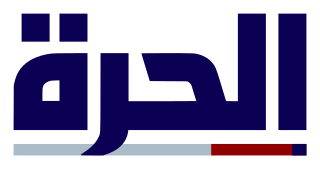
Al Arabiya is a Saudi state-owned international Arabic news television channel. It is based in Riyadh and is a subsidiary of MBC Group.

Alhurra is a U.S. government-owned Arabic-language satellite TV channel that broadcasts news and current affairs programming to audiences in the Middle East and North Africa. Alhurra is funded by the U.S. government and is barred from broadcasting within the United States itself under the 1948 Smith-Mundt Act.

Culture of Kuwait describes the cultural aspects of the Kuwaiti society and is part of the Eastern Arabian culture. Kuwaiti popular culture, in the form of dialect poetry, film, theatre, radio and television soap opera, flourishes and is even exported to neighboring states. Within the Arab states of the Persian Gulf, the culture of Kuwait is the closest to the culture of Bahrain.

MBC Group, formerly known as Middle East Broadcasting Center, is a Saudi media conglomerate based in the Middle East and North Africa region. Launched in London in 1991, the company moved its headquarters to Dubai in 2002 then moved to Riyadh in 2022.

Arab Radio and Television Network is an Arabic-language television network characterized by its multitude of channels. It is based in Jeddah, Saudi Arabia.
Television in Syria was formed in 1960, when Syria and Egypt were part of the United Arab Republic. It broadcast in black and white until 1976. In 1985 a second channel was established and in 1995 Syrian television rented a channel on Arabsat and it started broadcasting eight hours daily via satellite in 1996. Syrian channels are mostly owned and controlled by the Syrian Arab Television and Radio Broadcasting Commission (SATRBC) which is connected to the Ministry of Information. It has 4,800 staff; both government employees and freelancers.
Al-Resalah is an Arabic language satellite television channel "to present true Islam".

This page list topics related to Kuwait.
Kuwait television channel 2 (KTV2) is Kuwait's governmental television channel dedicated for the English-speaking public. The channel broadcasts English-speaking shows, local programmes, news, English-subtitled local serials, English-speaking international serials, and English-speaking or English-subtitled movies. Kuwait television started its broadcast on November 15, 1961; as the official television of the ministry of information of the state of Kuwait. There are so far five channels: channel 1, used for Arabic programming; channel 2 (KTV2); channel 3, for purely sports programming; channel 4 (KTV4), for pre-recorded and re-runs of movies and serials from other channels; and channel 5 (KTV-Plus), Kuwait's official governmental satellite broadcast, currently merged with KTV1. The Kuwait Ministry of Information has an online feed of three of its channels.
Television in Saudi Arabia was introduced in 1965, but is now dominated by just five major companies: Middle East Broadcasting Center, SM Enterprise TV, Lebanese Broadcasting Corporation, Rotana and Saudi TV. Together, they control 80% of the pan-Arab broadcasting market. Saudi Arabia is a major market for pan-Arab satellite and pay-TV. Saudi investors are behind the major networks MBC, which is based in Dubai, and Emirates based OSN. The Saudi government estimated that in 2000 the average Saudi spent 50% to 100% more time watching television than his or her European or US counterpart. On average, 2.7 hours are spent daily watching TV in Saudi Arabia.
The state broadcaster Kuwait Television operates the domestic channels, including KTV1, KTV2 and KTV Sport.
The General Organization of Radio and TV, also known in French as Organisation de la Radio et la Télévision Arabe Syrienne, is the state and public broadcaster in Syria and reports to the Ministry of Information. Earlier names were Radio and Television and Syrian Radio & Television (SRT).
'Ajam of Kuwait are Kuwaiti citizens of Iranian descent. The majority of Shia Kuwaiti citizens are of Iranian descent, although there are Ajam Kuwaitis who are Sunni.
Al Jazeera Arabic is a Qatari state-owned Arabic-language news television network. It is based in Doha and operated by the Al Jazeera Media Network, which also operates Al Jazeera English. It is the largest news network in the Middle East and North Africa region. It was founded in 1996 by the then Emir of Qatar Sheikh Hamad bin Khalifa Al Thani.
Bashar Al-Sayegh is a Kuwaiti journalist and politician.
Kuwait Ministry of Awqaf and Islamic Affairs is a cabinet department of the executive branch of the government of Kuwait dedicated to spreading tolerant Islamic culture. Specifically, it seeks to spread awareness and expand the influence of Islamic faith, Islamic history, and Islamic sciences.

Najla Ibrahim AlKanderi is a Kuwaiti television presenter and Radio presenter. She is best known for hosting several late-night TV shows in Kuwait including Bel Kuwaiti on the AlMajles TV and Layali Al Kuwait on the Kuwait Television.
The Ministry of Information is one of the governmental bodies in the State of Kuwait. It was established on 7 January 1979. The ministry is currently held by Abdulrahman Badah Al Mutairi.
Channel 3, formerly known as H2ZZ-TV and corporately known as Saudi Aramco Television or just Aramco TV was a Saudi terrestrial television station owned by ARAMCO, which in its later years broadcast entirely in English. The station broadcast from the Saudi Aramco Residential Camp in Dhahran.







